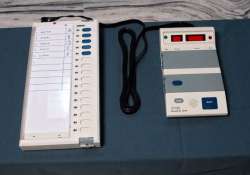CAG audit pushed EVMs
New Delhi: But for searching questions by the Comptroller and Auditor General of India (CAG) almost two decades ago, electronic voting machines (EVMs), that have become a hi-tech symbol of India's electoral efficiency and reliability,

New Delhi: But for searching questions by the Comptroller and Auditor General of India (CAG) almost two decades ago, electronic voting machines (EVMs), that have become a hi-tech symbol of India's electoral efficiency and reliability, may never have been fully introduced in the country.
According to a senior retired official of the Election Commission, the EVMs, which have made casting and counting of votes a hassle-free task, would have remained at the experimental system if the CAG had not pointed in 1996-97 to the tens of millions of rupees spent on developing the technology.
"It (EVM) as a concept was first conceived around 1977-78 to fight the problems of poll rigging, booth capturing and other such activities," the official told IANS here.
"As a follow-up to this, two public sector enterprises, Bharat Electronics and the Electronics Corporation of India, were given the mandate to develop the machines on an experimental basis."
According to the official, suggestions and advice from experts around the world and the country was sought on the ways to make the EVMs efficient and easily usable by even illiterates.
A small initial order for EVMs was placed for a Kerala byelection in 1981 but the Supreme Court struck down the results.
Not losing hope on the gen-next technology, the EC's views on using the EVMs was supported by the Goswami Committee on Election Reforms.
"It was only after the amendments in the Representation of the People Act and the conduct of Election Rules that the EC made detailed provisions for using the EVMs."
Placing an ambitious order of about 150,000 EVMs at a cost of Rs.75 crore from Bharat Electronics and the Electronics Corporation of India, the EC was set to introduce them in a phased manner in all the constituencies. However, financial and political obstructions scuttled the process.
"For around nine years, EVMs were not introduced in the country even though a large number had been purchased. This came to the notice of the CAG, which asked some tough questions," the official said.
In 1998, at the initiative of then chief election commissioner M.S.Gill, elections in Delhi, Rajasthan, Madhya Pradesh and Mizoram were conducted using the EVMs.
During the same period, the entire electoral rolls were computerised and photo identity cards were also issued.
Since 2004, the EC has conducted the elections to the Lok Sabha and the state assemblies only through EVMs.
According to a senior retired official of the Election Commission, the EVMs, which have made casting and counting of votes a hassle-free task, would have remained at the experimental system if the CAG had not pointed in 1996-97 to the tens of millions of rupees spent on developing the technology.
"It (EVM) as a concept was first conceived around 1977-78 to fight the problems of poll rigging, booth capturing and other such activities," the official told IANS here.
"As a follow-up to this, two public sector enterprises, Bharat Electronics and the Electronics Corporation of India, were given the mandate to develop the machines on an experimental basis."
According to the official, suggestions and advice from experts around the world and the country was sought on the ways to make the EVMs efficient and easily usable by even illiterates.
A small initial order for EVMs was placed for a Kerala byelection in 1981 but the Supreme Court struck down the results.
Not losing hope on the gen-next technology, the EC's views on using the EVMs was supported by the Goswami Committee on Election Reforms.
"It was only after the amendments in the Representation of the People Act and the conduct of Election Rules that the EC made detailed provisions for using the EVMs."
Placing an ambitious order of about 150,000 EVMs at a cost of Rs.75 crore from Bharat Electronics and the Electronics Corporation of India, the EC was set to introduce them in a phased manner in all the constituencies. However, financial and political obstructions scuttled the process.
"For around nine years, EVMs were not introduced in the country even though a large number had been purchased. This came to the notice of the CAG, which asked some tough questions," the official said.
In 1998, at the initiative of then chief election commissioner M.S.Gill, elections in Delhi, Rajasthan, Madhya Pradesh and Mizoram were conducted using the EVMs.
During the same period, the entire electoral rolls were computerised and photo identity cards were also issued.
Since 2004, the EC has conducted the elections to the Lok Sabha and the state assemblies only through EVMs.